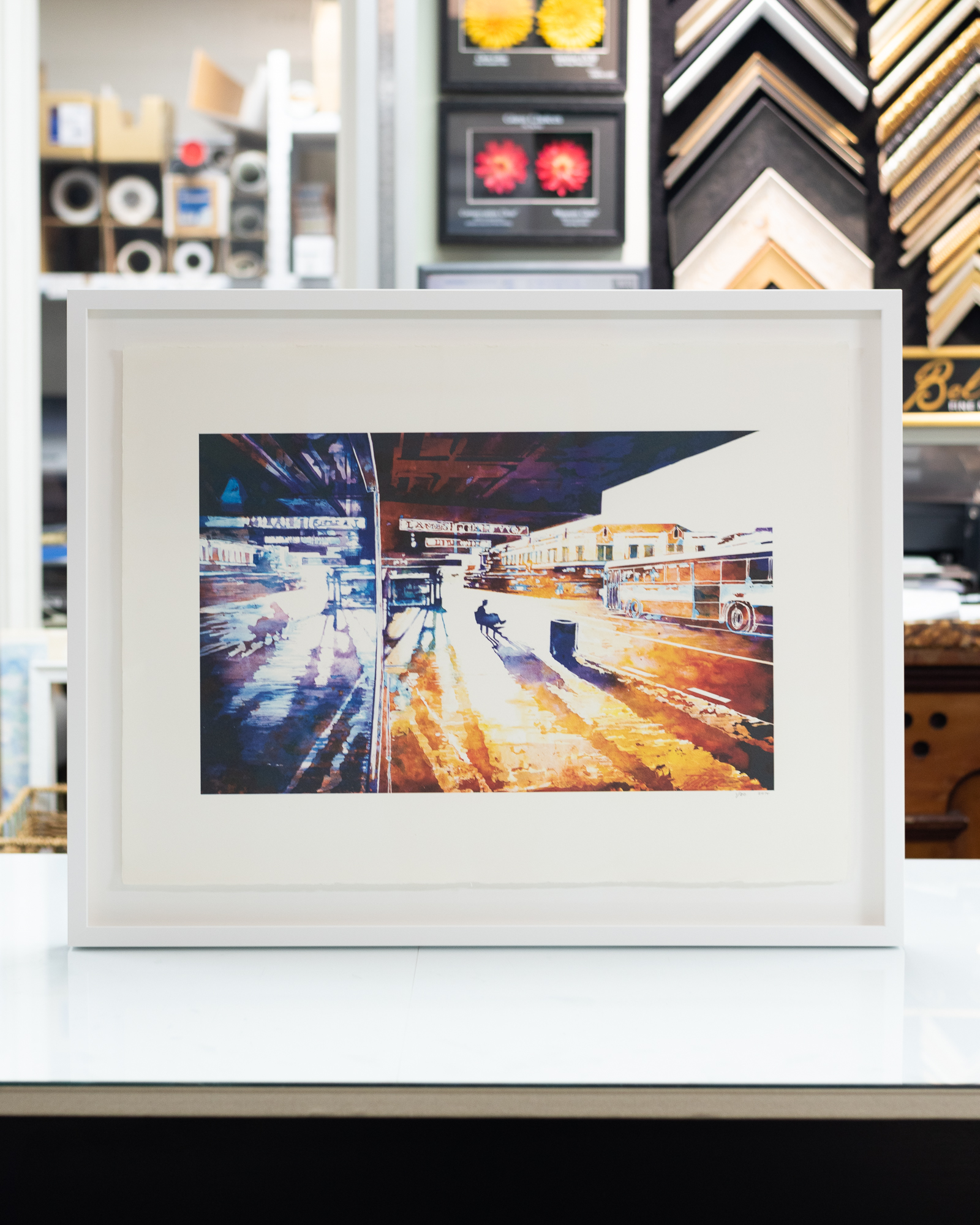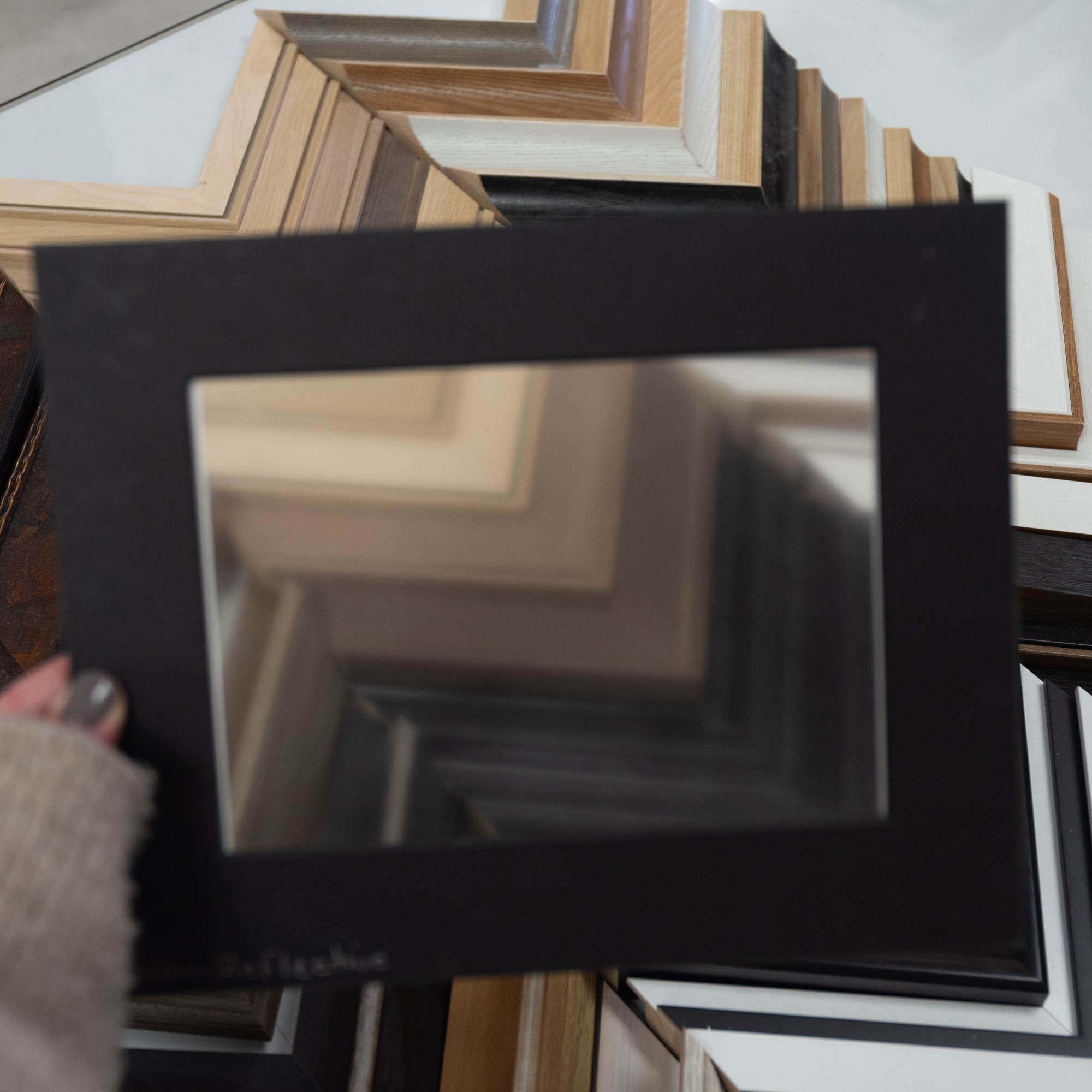What is Museum Glass and When Should I Use It?
Museum glass is one of the coolest products we have available to us in the picture framing world. It is one of the elements that goes into framing your artwork that can make the most impactful difference on the wall, and take something from looking great to looking even more striking.
What is it, and why it is different to normal glass?
Museum glass is a clarity, reflection control glass (often referred to as non-reflection glass or art glass). Where normal sheet glass is just that, normal glass, Museum Glass controls reflection from surrounding light sources, as well as being super clear so you can see more detail on your piece.
It is called Museum Glass, because it is a museum grade product used to ensure you can see exactly what is happening in the piece no matter what the lighting design for an exhibit is, as well as help protect the art from elemental damage. It is the product that leaves you wondering whether there is even glass on that painting or not, searching for a reflection that will give it away.
Why is it better than traditional non-reflective glass?
Non-reflective glass is a product that has been available in picture framing for a long time in an attempt to control how the light interferes with the viewing experience. The traditional product many are accustomed to is miles different from a museum grade glass however.
Traditional Non-Reflective Glass - blurs the subject when placed at a distance
Museum Glass - no blurring, acts like a normal glass with the added bonus of reflection control and ultra clarity.
The way the traditional product achieved reflection control was by having a slightly etched back to help control the light refraction. As a result though it has a diffusing effect as the glass is not totally clear, so the further away from the image it is from the glass, the more blurry the image appears. The only way to ensure you can see the detail in your piece would be to place the glass in contact with the artwork. Because having work touching the glass is not something we recommend as it goes against archival framing practices, it isn’t a product that works well in framing most items.
Museum glass, and its companion product UV70, control the light in a similar way to modern laptop screens, the formation of the glass helping to minimize glare, and are ultra clear (even sharper than clear glass). The result of this is no diffusion issues, so you can have it as close to or as far away from the artwork as you want, and is far more flexible in its application as a result, easily replacing normal sheet glass in any scenario where the piece will benefit from reflection control.
What is the difference between UV70 and Museum Glass?
In the modern reflection control glass family, there are two main options available.
The first is Museum Glass, and the other is what we call UV70. The only difference between the two is the UV protection. Museum Glass has 99% UV protection, which is the same as your standard UV filtering glass. It is designed to be amazingly clear, as well as protective for your art long term. The UV70 claims to have 70% UV protection on paper, but in New Zealand with our lack of ozone this doesn't mean much. We essentially see the UV70 product as the clarity glass versions of our standard clear glass, in that it doesn’t have any real UV protection to it.
Whether you need the Museum Glass or the UV70 depends entirely on the piece itself. Our team will be able to guide you in that decision making process, but if you want to learn more about where UV Glass is most useful, you can read more about that HERE.
How can I tell if I have one of these products already?
It is actually really easy for us to tell what kind of glass you have in your frame without pulling the frame apart, and both are quick and simple checks that anyone can do.
As a standard, each box of glass we order comes with a set of stickers to apply to the back of the frame that explain the care rules for Museum Glass, as well as tell you exactly what product you chose in case you forget 10 years down the line. We will ALWAYS add one of these stickers if you have a product that isn’t just standard sheet glass so you and anyone else will know for sure. UV Glass (also called conservation glass), UV70 (also called water glass) and Museum Glass all have corresponding stickers for this reason. No matter which framer you got the piece done at, they should do the same thing, but if there isn’t one, there is one other check you can do.
Failing the existence of a sticker, you can tell by just looking at it! Move yourself around until the view out the window, or a light bulb that is turned on is reflected in the glass. The light will be purple, green, or blue - some colour it isn't meant to be! That will tell you that you have the reflection control in the glass.
When you would use it?
We aren’t going to lie, Museum Glass comes with a bit of a jump in price, so we only recommend it to you when we really think your art work will benefit from it.
These are the guidelines we use for making that decision.
Is it really dark?
If your artwork is really dark and moody, as soon as you put normal glass over it it becomes almost like a mirror. The darker the colour behind, the more the brighter light shows up when it reflects off the glass. Sometimes with normal glass you wont be able to see anything in the frame if it is in a room with a lot of windows, or with stylised lighting that hits the artwork.
Is the artwork glossy?
Like with dark pieces of art, things that are really glossy become really reflective to light when you add another layer of gloss from the glass. Things like gloss paper stocks for photography, or prints with gloss detailing, benefit from a non reflective glass so that the glass doesn’t pick up as much of the light.
Is the artwork detailed?
Things with a lot of fine details, from embroidered pieces, to prints, are easier to see 1. With the superb clarity you get from museum glass and 2. Without reflections getting in the way. Museum glass makes it easier to see every detail in your special pieces.
Sometimes your artwork will be a combination of these things, the most common being a gloss photographic print that is really dark. So many things will benefit, like medals or prints with a lot of detail, but our team will always give your the pros and cons for the different options when consulting over your artwork. Every piece is different.
When you come in and see us, ask us about Museum Glass. We will always advise the best options for your artwork with your space in mind, to ensure you have the perfect final product when you get it home.



